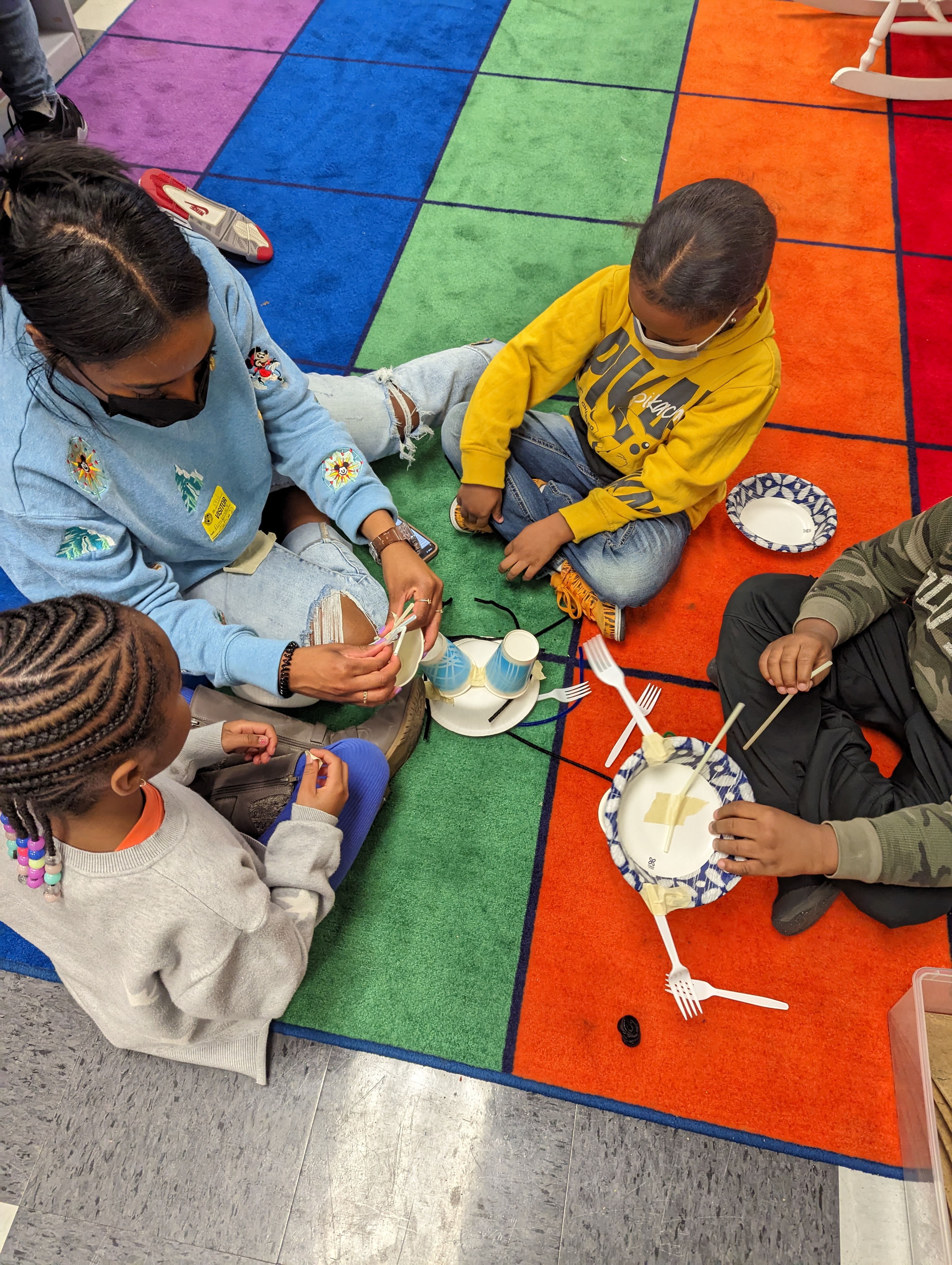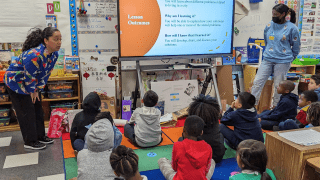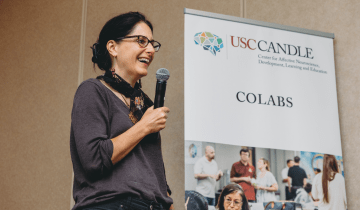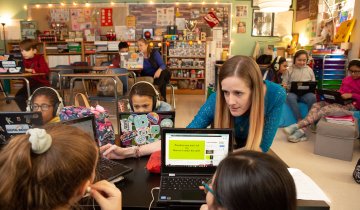In many teacher education programs, it’s routine for college faculty to review video recordings of their teacher-candidate students delivering lessons at school sites. From these videos, professors can provide feedback to their students. Watching video recordings of teacher candidates has long been a practice at the USC Rossier School of Education, but a new program is changing that. The USC–LAUSD Partnership School program simultaneously puts USC Rossier Master of Arts in Teaching (MAT) students and faculty into local schools. Faculty can observe the teacher candidates in the classroom and have a more complete understanding of the school dynamics and teacher–student interactions than video recordings can provide.
This new partnership builds on USC Rossier’s long-standing relationship with the Los Angeles Unified School District. USC Rossier has had a presence in LAUSD schools for many years, providing MAT students with opportunities to obtain hands-on experience in K–12 classrooms close to USC’s University Park Campus. In 2022, USC Rossier faculty in the MAT program decided to build on this relationship while also addressing the disconnect between what happens in their classrooms and what teacher education candidates experience in the field.
The USC–LAUSD Partnership School Program was created to facilitate collective conversations and apply the pedagogical and research-backed approaches taught in the MAT program to the school setting. This program not only benefits USC Rossier MAT students, it also provides professional development to LAUSD teachers and school leadership, while giving USC Rossier faculty valuable time in K–12 classrooms. The idea was to build a more reciprocal relationship with the demonstration site campus. The school’s experienced teachers and leadership receive enrichment and assistance. At the same time, USC faculty get to know a campus’ community, teachers and administration, helping them tailor their professional development workshops to the specific needs of the school.
“We wanted to improve the way that we prepare teachers for the transition of being in teacher education to being a full-time teacher by bridging the gaps that can exist between theory to practice. We did this by taking our MAT students with their faculty members to [partner schools] together to have collective conversations in the same space,” says Eugenia Mora-Flores, assistant dean of teacher education. Mora-Flores, who was instrumental in the creation of the program, also sought to enhance the experience of MAT students, “so they can be better prepared to serve their own future students and communities that they will be teaching in,” she says.
COLLECTIVE CONVERSATIONS AT 54TH STREET ELEMENTARY SCHOOL
One of the most successful partnerships of the new program is with 54th Street Elementary School, a K–6 school less than 6 miles from USC that serves South Los Angeles with a majority Black student body and Latino students as the next largest ethnic group. This school has been operating since 1895 and is a Title I school, which means it receives federal funds for students from low-income families. As part of the partnership, the entire multiple-subject MAT cohort visited the school, with approximately 25–30 USC students in attendance. During a visit, the MAT students would co-teach multiple lessons as their professors observed.
“Being in the classroom as a faculty member with the MAT students and the LAUSD teacher allowed me to see other things that I would have missed just watching our students on camera,” Mora-Flores says. “For instance, the 54th Street teachers could tell us when the elementary students who don’t speak up in class as much became more animated or interested in the lessons. We could ask the teachers why they thought the students were more engaged. When I was present in the classroom at the demonstration site, I could provide feedback with a level of depth that is much more sophisticated than the kind of feedback I would be giving from watching a recording.”
After a teacher-candidate facilitated a lesson, a collective debriefing session would follow that included USC Rossier faculty, MAT students and the elementary school staff. This allowed the student- teachers to receive feedback from different perspectives, including from the more experienced 54th Street School teachers. These educators could provide additional context about how their elementary students were experiencing the lessons since they had been working with the students for a much longer period of time. USC Rossier faculty had an opportunity to teach lessons at 54th Street as well. This experience helped the MAT teacher-candidates see that their at USC, but are scholar-practitioners who know how to apply theories and the latest research in an elementary school classroom. Teaching children again gave the USC faculty a chance to stay current and relevant in a K–12 setting and to show, not just tell, their student-teachers what to do.
“Being in the classroom as a faculty member with the MAT students and the LAUSD teacher allowed me to see other things that I would have missed just watching our students on camera.”
—Eugenia Mora-Flores, Assistant Dean of Teacher Education
“Being in an elementary classroom gave a different authenticity to the experience. This was a learning experience for me,” says Sandra Kaplan, professor of clinical education, who taught a few lessons at the school. “I can read hundreds of articles a semester and be immersed in scholarship, but to be back in an elementary school classroom and see what goes on was good for us as professors.”
Esthefany Salazar MAT ’23, now a third-grade teacher at City Language Immersion Charter School in Los Angeles, says being in the elementary classroom with her professors was enlightening.
“Observing and learning with the 54th Street Elementary School was helpful because we could debrief after observing master teachers—who have years of experience—deliver a lesson and have conversations about what we saw in the classrooms with our professors. We could directly reference what we saw in the elementary school classrooms with the theories we were learning in the MAT program, reinforcing what we were learning at USC,” says Salazar.
Natalie Dean MAT ’23, now a teacher at Richland Avenue School in LAUSD, says participating in the 54th Street partnership as a teacher-candidate gave her another place to see how concepts she was learning were being applied, beyond her own student-teaching placement and the videos she would watch of her peers. Being with peers and professors opened her eyes to some observations that she may not have first caught in a new setting.

REIMAGINING TEACHER PROFESSIONAL DEVELOPMENT
Part of establishing the reciprocal relationship between USC Rossier and 54th Street Elementary School involved hearing directly from the school’s teachers and leaders about areas of focus for professional development.
Usually, a professional development session involves an experienced teacher or professor delivering a lecture at a school or district office, with the school’s teachers taking notes while the facilitator hopes they aren’t getting bored. In the 54th Street partnership, USC Rossier professors configured the training sessions so they were working closely with teachers in their own classrooms much of the time. The USC faculty would make points that were more significant or relevant to what the elementary teachers were doing in their respective classrooms, providing feedback on ways to improve their teaching while also praising them for the areas where they excelled.
“This professional development experience was very specific to the classrooms that we were working with,” says Kaplan, who delivered the training along with professors Nasser Cortez and Shanta Smith. “It allows for a different level of comprehension because the teachers receiving the professional development can see what we are talking about with real students and receive feedback in real time.”
Because the professional development was not delivered in just one day by one expert, relationships between the teachers and USC professors formed.
Smith, an associate professor of clinical education at USC Rossier, provided a glimpse of the training that was offered.
“For the first year of the program, we unpacked math story problems and promoted student agency and metacognition,” Smith says. “Part of that process is modeling the mathematical practices that the students have to use in the classroom. With the metacognition piece, we talked about having the elementary students thinking out loud and how this can be an approach that is asset-driven and allows the teachers to see how students are thinking about what they are learning.”
Asset-based teaching practices focus on the students’ strengths and building up what they can do before facing new academic challenges. One strategy used to unpack math word problems was “Stop, Think and Act it Out,” which allows students to pause and analyze a problem, drawing upon their existing knowledge. These practices are particularly helpful for students from marginalized groups because they can focus on leveraging their assets to learn, whether that draws on their cultural, familial or neighborhood experiences. It’s a more student-centered approach to learning.
Deborah Francois, the targeted student programs coordinator at 54th Street Elementary School, says that, through the partnership, teachers were able to meet goals the district had asked them to work on, such as being more student-centered, letting students drive their own learning and engaging in more inquiry-based practices. Faculty offered many approaches for 54th Street teachers to refine these skills by working directly beside them in the classroom.
“The teachers at our school have been very positive and enthusiastic about what the team at USC brought to them,” Francois says. “I have had the opportunity to visit classrooms when the teachers were implementing some of these strategies that they learned in professional development, and we are starting to see some real instructional shifts at our school site. We can’t attribute this entirely to USC and our partnership, but it’s part of it.”
Experiential learning, hands-on learning and learning through play were some of the strategies faculty worked on with the school’s teachers. For teachers who may have been trained in different strategies and are several years removed from their experience in teacher education, Francois said that being able to interact and learn from the USC Rossier professors provided a fresh perspective and leveled up their pedagogical practices with more current student-centered strategies.
“I can read hundreds of articles a semester and be immersed in scholarship, but to be back in an elementary school classroom and see what goes on was good for us as professors.”
—Sandra Kaplan, Professor of Clinical Education
One professional development session showed how students can learn science, technology, engineering, arts and math (STEAM) concepts through play and making new things. Smith, a former principal at two magnet STEAM schools, took the lead in the session at the school’s maker space, helping teachers learn how to maximize the learning experience for their students. STEAM activities in a maker space start with design thinking about a problem. Then, with teacher guidance, students work to develop a solution using items in that space, often building models or prototypes. Judith Cawthorne, a kindergarten teacher at 54th Street, developed an activity based on the problem faced by the billy goats in the children’s classic The Three Billy Goats Gruff. Students were provided with materials to build a bridge or create a different way to cross a brook safely.
For several years, 54th Street Elementary School had been a Tier 3 priority school, meaning its academic performance was among the lowest in the district. Within the past year, test scores have improved, and now the school has emerged out of that category. The school is on an upward trajectory, according to Francois, which is gaining notice from LAUSD leadership. Francois credits the USC partnership as being instrumental in student growth and stronger student performance.
“What I have appreciated most about this partnership is that this has been something that leadership in the district has supported, so it goes beyond just this school,” Francois says. “We feel supported by LAUSD leadership in working with USC. On the USC side, working with the faculty and Dean Pedro Noguera has been wonderful. The dean has also made connections with district leadership to let them know what we have been doing.”
When the program first launched at 54th Street Elementary in the 2022–2023 school year, four teachers from the school participated in partnership. Last year, that number had risen to nine, so now the school is seeing results on a larger scale.
From this initial partnership with USC Rossier, the team at 54th Street Elementary School has also engaged with the USC Viterbi School of Engineering, which is providing after-school engineering classes for the elementary students. In addition, 54th Street may soon become a school for USC Rossier to provide student-teachers beyond the demonstration-site partnership, further strengthening the connections between this neighborhood school and work being done at the University Park Campus.






